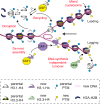Histone modifications and a choice of variant: a language that helps the genome express itself
- PMID: 25343033
- PMCID: PMC4166940
- DOI: 10.12703/P6-76
Histone modifications and a choice of variant: a language that helps the genome express itself
Abstract
Covalent post-translational modifications on histones impact chromatin structure and function. Their misfunction, along with perturbations or mutations in genes that regulate their dynamic status, has been observed in several diseases. Thus, targeting histone modifications represents attractive opportunities for therapeutic intervention and biomarker discovery. The best approach to address this challenge is to paint a comprehensive picture integrating the growing number of modifications on individual residues and their combinatorial association, the corresponding modifying enzymes, and effector proteins that bind modifications. Furthermore, how they are imposed in a distinct manner during the cell cycle and on specific histone variants are important dimensions to consider. Firstly, this report highlights innovative technologies used to characterize histone modifications, and the corresponding enzymes and effector proteins. Secondly, we examine the recent progress made in understanding the dynamics and maintenance of histone modifications on distinct variants. We also discuss their roles as potential carriers of epigenetic information. Finally, we provide examples of initiatives to exploit histone modifications in cancer management, with the potential for new therapeutic opportunities.
Figures


References
Publication types
LinkOut - more resources
Full Text Sources
Other Literature Sources

